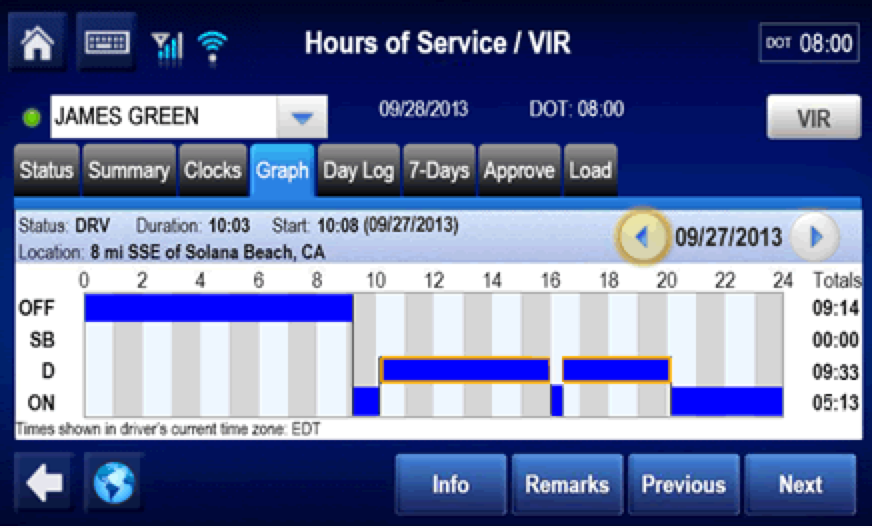Omnitracs Demonstrates its Commitment to Electronic Logging Mandate
Omnitracs, a leading pioneer in fleet management solutions serving transportation and logistics companies, has reinforced its commitment to regulatory compliance.
Toward that end, the company has been identifying the required modifications for the electronic logging device (ELD) technology to ensure products will comply with the Federal Motor Carrier Safety Administration’s (FMCSA) final ruling on ELDs, which became effective on Jan. 16, 2016.
Omnitracs has been educating its customers on the importance of the final ruling, noting that it represents a new era of modern and accurate methods for recording of hours of service (HOS), while simultaneously delivering additional and universal benefits to fleets.
An estimated 3.1 million commercial drivers are now subject to the ELD mandate, and fleets of all sizes are turning to the pioneer of commercial vehicle telematics as they adopt technology that will ensure they adhere to the requirements of the new regulation, and will also look beyond basic compliance to realize additional advantages associated with ELDs, such as increased safety and enhanced productivity.
By way of background, an ELD is a device that automatically records driving time and monitors engine hours, vehicle movement, miles driven and location information. ELD technology electronically and automatically collects data to ensure compliance with federal HOS rules, which are designed to prevent driver fatigue and prevent fatigue-related collisions.
The good news is that ELDs put an end to the use of antiquated and often inaccurate “pencil and paper” methods to manually record hours driven. Anyone required to maintain record of duty status (RODS)—including large and small fleets, as well as individual owner-operators—is affected by the ELD mandate. Exceptions have been made for vehicles manufactured prior to 2000, drivers operating under the definition of “drive-away tow-away operation,” and drivers using RODS fewer than eight days in a 30-day period.
 “With the final ruling published, the commercial trucking industry finds itself in a new era that brings hours of service (HOS) management into the modern age and delivers numerous other benefits related to the use of advanced technology,” commented Tom Cuthbertson, vice president of regulatory compliance at Omnitracs. “The mandate is a monumental undertaking for the FMCSA, and Omnitracs understands and supports the positive results and anticipated impact it will have on safety, accident reduction, and operational efficiency.”
“With the final ruling published, the commercial trucking industry finds itself in a new era that brings hours of service (HOS) management into the modern age and delivers numerous other benefits related to the use of advanced technology,” commented Tom Cuthbertson, vice president of regulatory compliance at Omnitracs. “The mandate is a monumental undertaking for the FMCSA, and Omnitracs understands and supports the positive results and anticipated impact it will have on safety, accident reduction, and operational efficiency.”
He continued, “Omnitracs is innovation driven, and we’re committed to ensuring that all of our solutions are vetted and adhere to current regulations as they develop. It’s critically important that fleets become educated about the ruling and how it applies to them. Furthermore, we’re looking forward to working with our current and future customers as they adopt ELD technology and mandate compliance practices.”
With the final ruling amounting to 516 pages, there are several key takeaways that all carriers and drivers should be mindful of:
- With up to 40 percent more data required at roadside inspections under the new regulation, the ELD mandate clarifies how to provide data in a standardized format and how to transmit information to law enforcement;
- The mandate now makes available an extensive record of duty status file to be transferred to a roadside inspection stop or at a weigh scale inspection, which will help save invaluable time for carriers and drivers alike;
- The timeline for adoption started with the final rule published Dec. 16, 2015 and was effective starting Jan. 16, 2016;
- The compliance date is Dec. 16, 2017, while Dec. 16, 2019 marks the last date to be able to use an automatic onboard recording device (AOBRD);
- Prohibition of Coercion—a related rule prohibiting acts of coercion aimed at compelling drivers to violate safety regulations—takes effect Jan. 29, 2016; violation of this rule now incurs a penalty of up to $16,000;
- Smartphones and other wireless devices can be used as an ELD so long as they satisfy technical specifications, are certified, and are listed on the FMCSA website; and,
- Canadian- and Mexican-domiciled drivers will be required to use ELDs when operating on U.S. roadways.
Concluded Cuthbertson, “Our customers have a lot of questions, and one of the ways that Omnitracs is helping fleets avoid the pitfalls of misinterpretation is through regular webinars where we dissect a topic and review the actualities.”
Carriers and drivers looking for more information about the final ruling and how to decipher what it all means should visit ELDfacts.com where presentations from industry experts, white papers, and analysis tackling technical questions and compliance topics are available for download. Fleet managers can also review a recording of the recent webinar, “The ELD Mandate: Are You Prepared?” to learn first-hand from Omnitracs compliance expert, Tom Cuthbertson, more about the mandate and what fleets must know to stay compliant.
About Omnitracs, LLC
Omnitracs, LLC is a global pioneer of fleet management, routing and predictive analytics solutions for private and for-hire fleets. Omnitracs’ nearly 1,000 employees deliver software-as-a-service-based solutions to help more than 50,000 private and for-hire fleet customers manage nearly 1,500,000 mobile assets in more than 70 countries. The company pioneered the use of commercial vehicle telematics over 25 years ago and serves today as a powerhouse of innovative, intuitive technologies. Omnitracs transforms the transportation industry through technology and insight, featuring best-in-class solutions for compliance, safety and security, productivity, telematics and tracking, transportation management (TMS), planning and delivery, data and analytics, and professional services.
Category: Telematics













